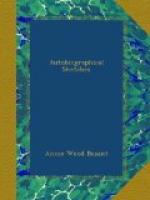The propaganda of Freethought was not forgotten while this Malthusian quarrel was raging, and in August 1877 the Freethought Publishing Company issued the first English edition of lectures by Colonel Robert Ingersoll, the eminent Freethought advocate of the United States. Since that time various other publishers have circulated thousands of his lectures, but it has always been to me a matter of satisfaction that we were the first to popularise the eloquent American in England. The ruling of the Lord Chief Justice that a book written with pure intention and meant to convey useful knowledge might yet be obscene, drew from me a pamphlet entitled, “Is the Bible Indictable?”, in which I showed that the Bible came clearly within the judge’s ruling. This turning of the tables on our persecutors caused considerable sensation at the time, and the pamphlet had, and still has, a very wide circulation. It is needless to add that the Sunday Freethought lectures were carried on despite the legal toils of the week, and, as said above, the large audiences attracted by the prosecution gave a splendid field for the inculcation of Freethought views. The National Secular Society consequently increased largely in membership, and a general impulse towards Freethought was manifest throughout the land.
The year 1878, so far as lecturing work was concerned, was largely taken up with a crusade against the Beaconsfield Government and in favor of peace. Lord Beaconsfield’s hired roughs broke up several peace meetings during the winter, and on February 24th Mr. Bradlaugh and Mr. Auberon Herbert, at the request of a meeting of working-class delegates, held in Hyde Park a “Demonstration in favor of Peace”. The war party attacked the meeting and some sharp fighting took place, but a resolution “That this meeting declares in favor of peace” was carried despite them. A second meeting was called by the Working Men’s Committee for March 10th, and a large force of medical students, roughs, militia-men, and “gentlemen”, armed with loaded bludgeons, heavy pieces of iron, sticks with metal twisted round them, and various sharp-cutting weapons, went to Hyde Park to make a riot. The meeting was held and the resolution carried, but after it had dissolved there was some furious fighting. We learned afterwards that a large money reward had been offered to a band of roughs if they would disable Mr. Bradlaugh, and a violent organised attack was made on him. The stewards of the meeting carried short policemen’s truncheons to defend themselves, and a number of these gathered round their chief and saved his life. He and his friends had to fight their way out of the park; a man, armed with some sharp instrument, struck at Mr. Bradlaugh from behind, and cut one side of his hat from top to brim; his truncheon was dinted with the jagged iron used as weapon; and his left arm, with which he guarded his head, was one mass of bruises from wrist to elbow. Lord Beaconsfield’s friends very nearly succeeded in their attempt at murder, after all, for a dangerous attack of erysipelas set in, in the injured arm, and confined Mr. Bradlaugh to his room for sixteen days.




